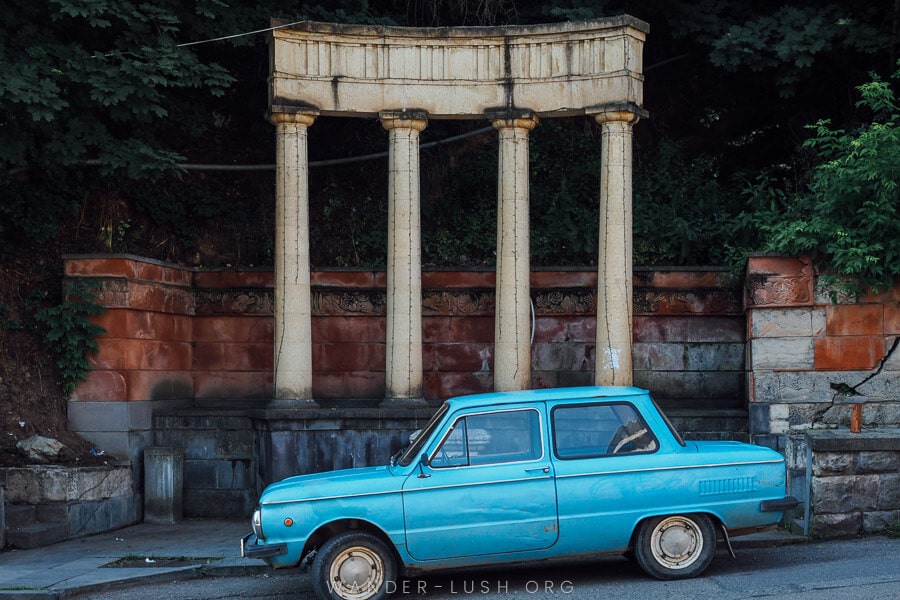Armenia is world-renowned for its lofty cathedrals and stunning sacred sites. Here are 21 of the most beautiful Armenian churches and monasteries to visit in Yerevan and around the country.
You might know Armenia as the land of apricots – well, it’s also the land of churches!
The Kingdom of Armenia was the first nation to adopt Christianity as its official religion in 301 AD. That legacy lives on in the 4,000-plus Armenian Apostolic churches and monasteries dotted around the country.
On my multiple trips to Armenia I’ve been lucky enough to see many of the country’s most beautiful monasteries and sacred sites in person. This list brings together 21 of the most important and beautiful churches in the country, each valued for their history and architecture.
Church or monastery?… A church is typically a single building, while a monastery (or convent) is a larger complex containing multiple churches and chapels, refectories, libraries, etc. often protected by fortified walls. This list includes both churches and monasteries.
Please note: This post contains affiliate links, meaning I may earn a commission if you make a purchase by clicking a link (at no extra cost to you). Learn more.
What makes Armenian churches so special?
Armenia is world-renowned for its unique ecclesiastical architecture. Because Christianity has been around for so long, it has quite naturally become interwoven with Armenian identity and influences almost every aspect of local culture, especially architecture.
Some of the most notable Armenian monasteries were built during the medieval era. Structures from this period have distinctive characteristics that are quite easy to spot:
Vertical shape: Armenian churches are usually taller than they are wide. This is both symbolic (reaching skywards) and practical. You might know that Armenia is prone to earthquakes; the stout, sturdy shape is designed to safeguard against natural disasters.
Pointed dome: You’ll notice that many churches have a broad, pointed dome. This is said to represent the volcanic cone of Greater Ararat, the biblical mountain that is Armenia’s national symbol.
Gavit: Many churches from the 10th and 11th centuries feature a gavit or zhamatun, a ‘hall’ of sorts normally attached to the western side and used as a narthex and mausoleum. The most impressive gavit I’ve seen is fixed to the Church of the Holy Redeemer at Sanahin Monastery. Completed in 1181, it has a spine of four huge free-standing pillars running down its centre.
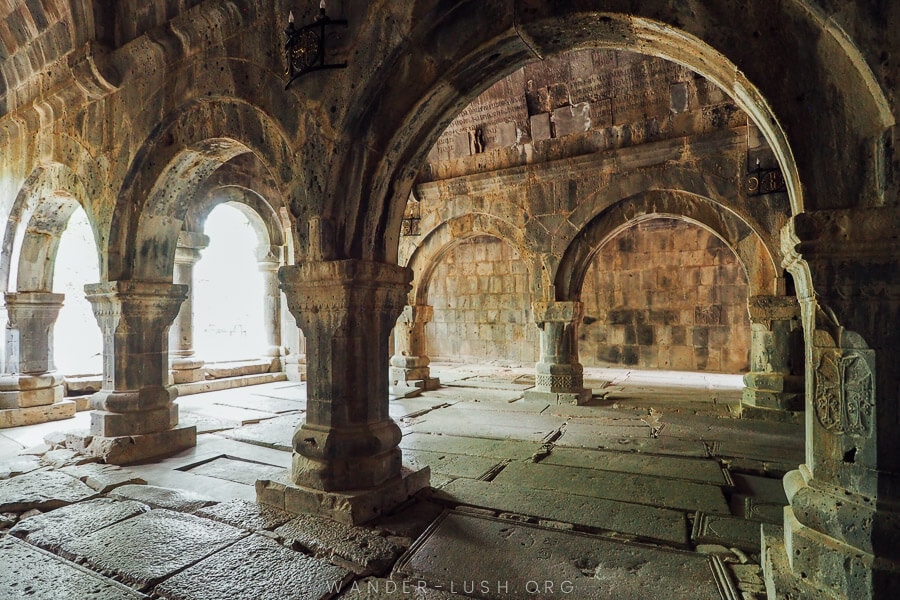
Tuff stone & basalt: Armenia has few forests to source timber from, therefore the majority of churches (and other non-religious buildings) are made from stone. Volcanic tuff stone and basalt in natural shades of pink, ochre and black are both commonly used. Architects either achieved a clean, tidy facade in one uniform colour by using a special ground-stone mortar to join the slabs together, or arranged the stone blocks in a striped or chequered pattern for interest.
Frescoes & carved reliefs: Painted frescoes and stone carvings are commonly used to decorate the doorways and interiors of churches. Like khachkars, stone bas-reliefs typically feature interlacing patterns of grapevines and apricots.
Khachkar stones: Khachkar ‘cross-stones’ are one of the most important components of Armenian architecture and can always be found built into church walls or scattered around the yard. These carved tablets bear beautiful inscriptions and patterns of interlacing lines, pomegranates and biblical figures. Khachkars first appeared in the 9th century and are still used to this day as talismans signifying salvation and protection.
Fun fact: Active churches in Armenia have music playing throughout the day and night, so you’ll always hear chanting playing through the loudspeakers when you enter inside a church.
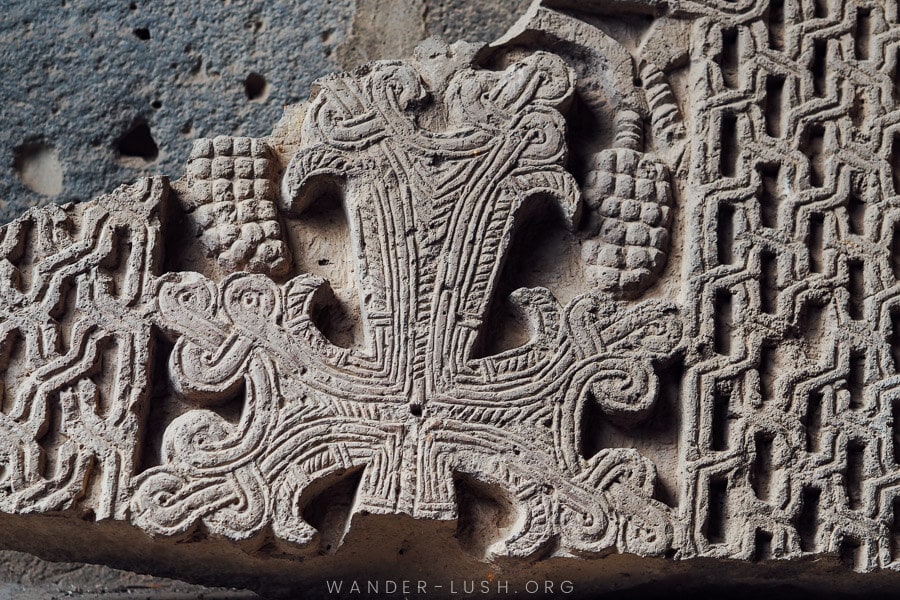
Map of churches in Armenia
Top 3 Armenian churches in Yerevan
1. Holy Mother of God Katoghike Church, the oldest Catholic church in Yerevan
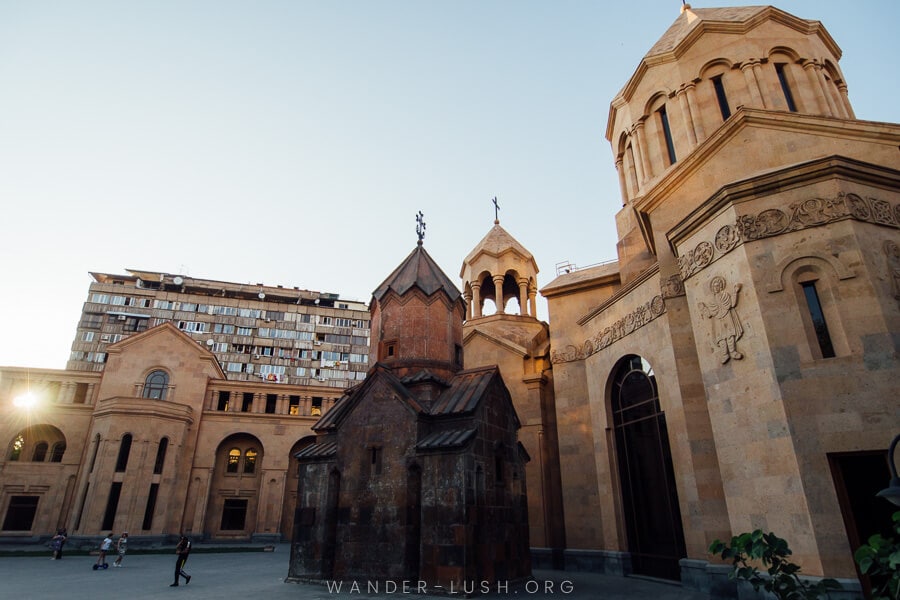
- Armenian name: Kat’oghike Surp Astvatsatsin Yekeghetsi
- Year: Completed in 1264
- Location: 17 Abovyan St, Yerevan
The Holy Mother of God Katoghike Church is considered to be the oldest church in Armenia’s capital city, Yerevan. Sandwiched between tall apartment buildings in central Kentron district, it’s tiny and very easy to miss. If it weren’t for the large plaza out front, I think most people would walk right by!
Indeed this church was kept a secret for many decades. After a devastating earthquake in 1679 partially destroyed the church, a new basilica was built in its place. It wasn’t until 1936 that part of the original chapel was uncovered during construction works. Pleas to the Soviet government were heard, and Katoghike was saved from demolition.
On my first trip to Yerevan I visited this church on Orthodox Easter Sunday. The tiny chapel – just 5.4 x 7.5 metres – is barely big enough to fit a dozen people and feels very intimate. Adjacent to Katoghike, the much larger Saint Anna Church was consecrated in 2015.
TIP: To see a beautiful collection of khachkar stones in Yerevan, head to the open-air memorial park near Republic Square and the Vernissage souvenir market.
2. Saint Gregory the Illuminator Cathedral, the largest Armenian Apostolic church in the world
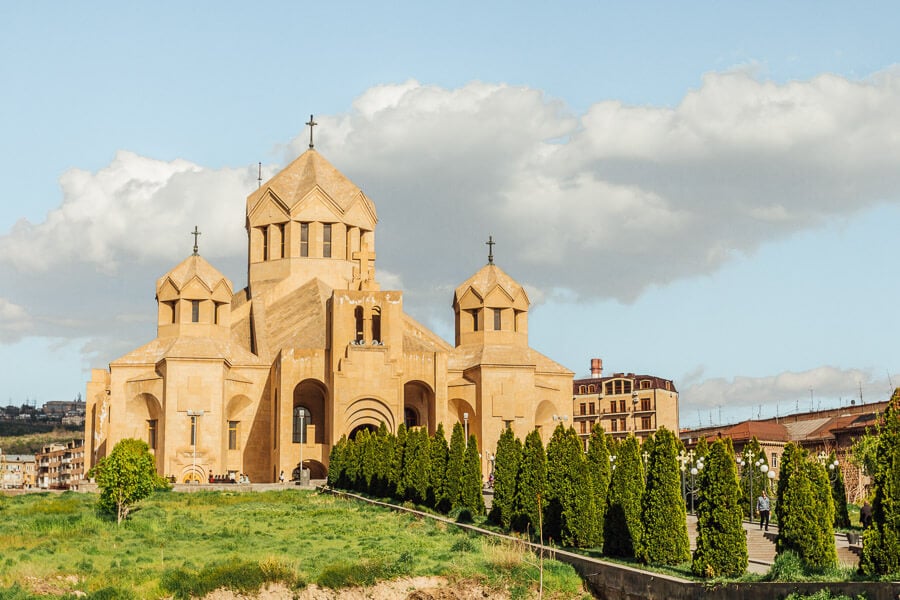
- Armenian name: Surb Grigor Lusavorich Mayr Yekeghetsi
- Year: Completed in 2001
- Location: Yervand Kochar St, Yerevan
At the opposite end of the spectrum to the humble Katoghike Church, the monumental Saint Gregory the Illuminator Cathedral is the biggest church in Yerevan and the largest Armenian Apostolic church in the world.
Located at the end of a long, shallow, tree-lined boulevard-stairway, it bears some resemblance to Sameba Cathedral, the biggest Georgian Orthodox church in Tbilisi. It consists of three separate churches united under a cross-topped angular dome that towers 54 metres high.
Construction began in 1997 and culminated in September 2001, coinciding with the 1700th anniversary of the proclamation of Christianity as Armenia’s state religion. The unpainted cathedral interior is very sparse. Members of the global Armenian community make a pilgrimage here to the relics of Saint Gregory the Illuminator, the nation’s patron saint, and the Holy Remains of St. Gregory, relocated here from Naples.
3. Saint Sargis Vicarial Cathedral, a beautiful church in Yerevan’s oldest district
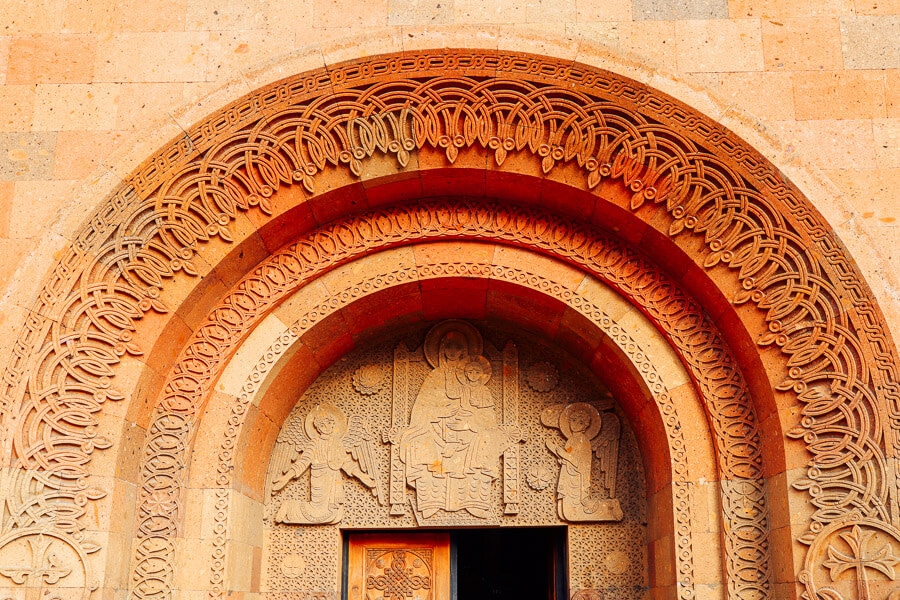
- Armenian name: Surp Sarkis Mayr Yekeghetsi
- Year: Completed in 1842
- Location: 21 Israyelyan St, Yerevan
This unusual church is located in Kond, Yerevan’s oldest residential district. Its stout shape, vertical slit windows and belltower, and ornately carved stone arches are quite typical – yet the modernist, almost Brutalist shapes make Saint Sargis unique among the city’s many churches.
Kond is one of my favourite places to walk in Yerevan. The church’s location amongst tumbledown houses overlooking the leafy Hrazdan gorge – a green oasis in the city centre – is very special.
Saint Sarkis used to be part of a larger hermitage-monastery complex that was destroyed in the 1679 earthquake. The church we see today was rebuilt in 1835-42. Further renovations in 1972 preserved the facade, which is lined with distinctive orange tuff stone from Ani and adorned with triangular niches.
Churches in Armenia that are UNESCO World Heritage Sites (official & tentative)
4. Geghard Monastery, the church in the cliff

- Armenian name: Geghardavank (‘Monastery of the Spear’)
- Year: Founded in the 4th century
- Location: Geghard, Ararat Province (1 hour east of Yerevan)
A popular day trip from Yerevan, Geghard is both one of Armenia’s most important religious landmarks and a place of spectacular natural beauty. If there’s one Armenian monastery that perfectly achieves unity with the surrounding landscape, it’s Geghard.
The complex was founded in the 4th century by Saint Gregory the Illuminator and built-up around a freshwater spring unearthed in a nearby cave (not unlike Vardzia in Georgia). It housed a number of important relics, including the spear that wounded Jesus at the Crucifixion. This gives Geghard its name, the ‘Monastery of the Spear’.
The use of locally quarried stone for the main chapel (built in 1215) creates the effect of emerging directly from the rocky cliffs that shelter the complex. Smaller chapels, cave cloisters and narthex halls are spread out over multiple levels, some of them literally carved out of the mountainside. When UNESCO inscribed the monastery on the World Heritage List in 2000, it also included the surrounding Upper Azat Valley – that gives you an idea of just how essential a role the landscape plays.
My favourite part of Geghard is definitely the western narthex, a vacuous stone hall with four large, free-standing columns. A single beam of light reaches down from a small opening in the stone roof for a truly mystical scene. The adjacent Upper Jhamatun chamber is another highlight, mainly because of the otherworldly acoustics. I would love to hear a vocal performance in here!
5. Haghpat & Sanahin, twin monasteries in northern Armenia

- Armenian names: Haghpatavank & Sanahin
- Years: Founded in the 10th century
- Location: Alaverdi, Lori Province (3 hours north-east of Yerevan)
Armenia’s first UNESCO World Heritage Site, the twin monasteries of Haghpat and Sanahin are located in the far north, close to the border with Georgia. This part of Armenia is a breathtaking landscape of rocky gorges, pancake-flat plateaus and old copper mines. It’s my favourite part of the country by far.
Haghpat and Sanahin both overlook the gorge – just 15 kilometres apart – and were both founded by Queen Khosrovanuysh some time between 966-976 AD. This period under the Bagratid Dynasty was an auspicious era for Armenian architecture, when a huge number of important churches, cities and monuments – including the Cathedral of Ani and the Cathedral on Akdamar Island (both in present-day Turkey) – were also built.
The monasteries are coupled as one UNESCO Site because of their close proximity and likeness. Both combine Byzantine and vernacular elements for a unique synthesis of styles. Both also served as centres of learning: in the case of Sanahin, it housed a school for manuscript illuminators and calligraphers.
There is something of an ongoing rivalry between the two – Sanahin claims to be the senior monastery, its name meaning something along the lines of ‘this one is older than that one’.
Read my full guide to visiting the monasteries from the nearby city of Vanadzor. You can also visit these monasteries on a day trip from Tbilisi – find out more here.
7. Etchmiadzin Cathedral, one of the oldest Christian churches in the world

- Armenian name: Ejmiatsni Mayr Tacar
- Year: Completed in 303 AD
- Location: Vagharshapat (30 minutes west of Yerevan)
Last but certainly not least among Armenia’s UNESCO-listed churches, Etchmiadzin Cathedral is the seat of the Apostolic Church and the most important sacred site in the country.
Scholars believe that Holy Etchmiadzin was the first cathedral built in Ancient Armenia. And since Armenia was the first Christian nation, this naturally makes it the oldest cathedral in the world. According to legend, patron saint Gregory the Illuminator founded the church on the occasion of the nation’s conversion to Christianity, erecting Etchmiadzin rather symbolically on top of an old pagan temple.
As you can imagine, Etchmiadzin has been damaged, rebuilt and altered countless times throughout its history. Yet incredibly the bones of the church are much the same as they were in the 5th century. The basic form, a central-domed cross-hall, was pioneered here and would go on to influence architecture and art across Armenia and the rest of the region.
The exterior is austere, but the interior is stunning, with floridly frescoed domes (some originals painted by Naghash Hovnatan in the early 1700s), a painted altar, and lots of carvings. Don’t miss the stone relief of Gregory the Illuminator on the western belfry.
8. Saint Hripsime Church, a former mausoleum
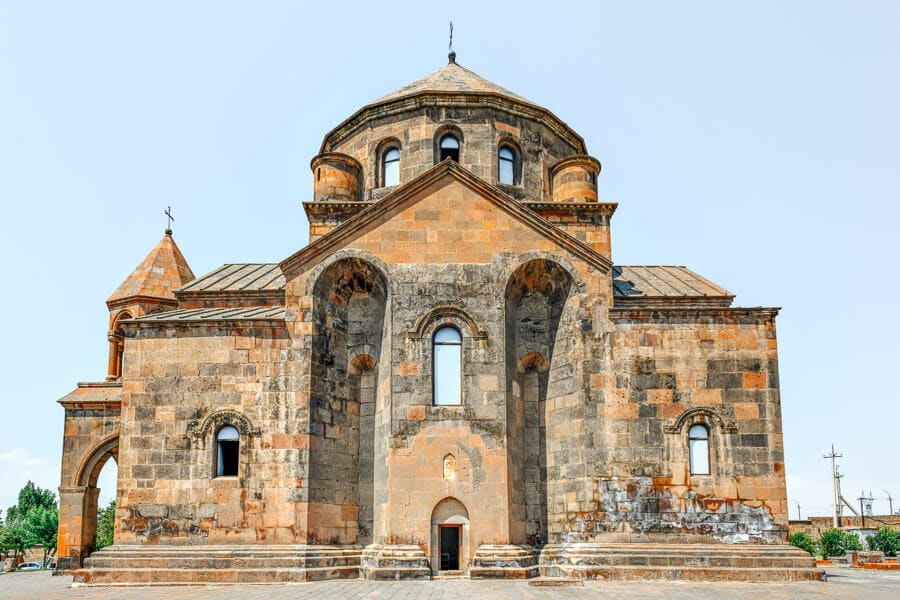
- Armenian name: Surb Hripsime Yekeghetsi
- Year: Completed in 618 AD
- Location: Vagharshapat (30 minutes west of Yerevan)
Named after Saint Hripsime, a Roman martyr who is commemorated every year on June 4, this church in Vagharshapat is close to Etchmiadzin Cathedral and part of the same UNESCO World Heritage complex.
Another of Armenia’s oldest churches, it was originally built in 395 AD as a mausoleum for Saint Hripsime. The new church was completed three centuries later and still contains her relics in its subterranean catacombs.
The ashen-coloured church has a pleasing symmetrical design with a tower at one end. Its close proximity to the Mother See of Holy Etchmiadzin and Zvartnots makes it easy to visit all three in the same trip.
9. Zvartnots, ruins of a tetraconch cathedral

- Armenian name: Zvartnots (‘Celestial Angels Cathedral’)
- Year: Completed in 652 AD
- Location: Vagharshapat (20 minutes west of Yerevan)
Just a few kilometres down the road from Etchmiadzin and also covered by UNESCO, the ruins of the 7th century Zvartnots Cathedral is one of the most intriguing places to visit in Armenia.
Monumental tuff blocks scattered around the landscape attest to the destruction that befell this place – historians believe the cathedral was destroyed in an earthquake just 320 years after it was completed. Like Etchmiadzin, Zvartnots was dedicated to Saint Gregory the Illuminator and located on the spot where he met with King Trdat III to seal Armenia’s fate as a Christian nation.
Today, reconstructed capitals and columns allude to the church’s unusual tetraconch shape. The entire structure is open and hollowed out, revealing a panoramic view of Mount Ararat through the gaps.
9. Tatev Monastery & Tatevi Anapat, mountaintop Armenian churches in the south
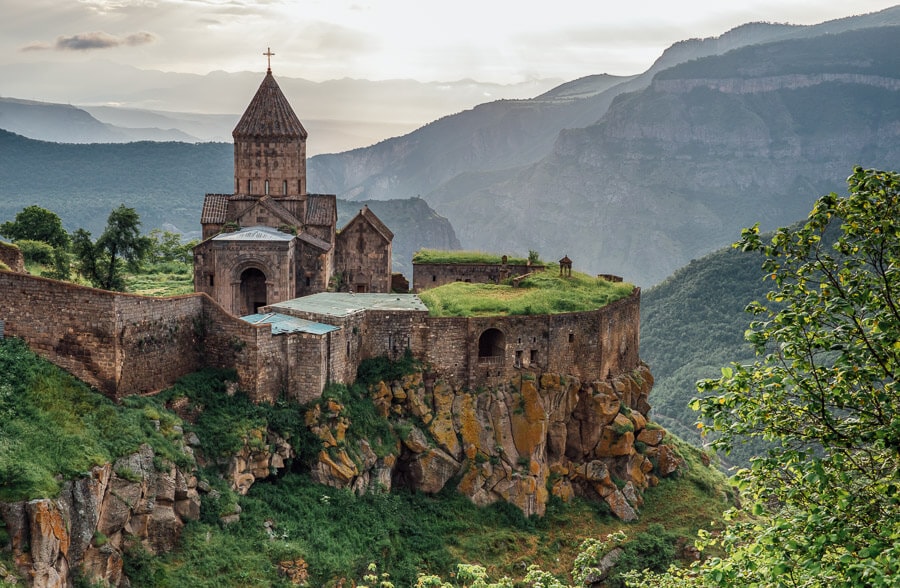
- Armenian name: Tatevivank & Tatevi Mets Anapat
- Years: Founded in the 9th century & 17th century
- Location: Halidzor, Syunik Province (4 hours south-east of Yerevan)
Perched on a basalt rock plateau overlooking Armenia’s deepest gorge, Tatev is probably the most recognisable monastery in the country. Along with the nearby Tatevi Anapat, it has been a tentative UNESCO World Heritage Site since 1995.
Beautiful as the details of its stone carvings and khachkar stones are, this monastery is all about the views – and the entrance. The Wings of Tatev, a 5.7 kilometre-long ropeway that connects the monastery with the nearest town, is the longest non-stop double track cable car in the world. I will never forget sailing over the gorge and getting my first glimpse of Tatev. It’s unreal.
Edged in by defensive walls, the Tatev complex holds three churches, a library, refectory and mausoleum. From 1390-1434 Tatev hosted one of Armenia’s most prestigious universities, attracting scholars from around the region.
Located in the Vorotan gorge and visible from the cable car, Tatevi Anapat dates to the 17th century. According to some sources, it served as an important hermitage and housed more than 700 scholars and manuscript writers, making it one of the largest religious centres in the Caucasus at the time. Tourism infrastructure is currently under development – for now, you can visit Tatevi Anapat on the hike from Halidzor to Tatev.
Tatev is located in Armenia’s ‘deep south’, not far from the Iranian border. Read my full guide to visiting Tatev from Yerevan on a day trip.
10. Noravank Monastery, the most beautiful monastery in Armenia

- Armenian name: Noravank (‘New Monastery’)
- Year: Founded in 1105 AD
- Location: Yeghegnadzor, Vayots Dzor Province (2 hours south-east of Yerevan)
Located outside the Areni wine region in central Armenia, Noravank is another popular monastery that’s often included as a stop on the journey between Yerevan and Tatev. It’s not the biggest, oldest or even the most important monastery in Armenia – but in my eyes, it’s the most beautiful.
Tucked in a grassy depression beneath a wall of auburn rock, Noravank’s defining feature is the Holy Mother of God Church (Surb Astvatsatsin), with a distinctive cantilevered double staircase embedded in its front facade.
There’s something special about the stone carvings of John the Baptist, Jesus and Adam above the doorways and windows, too. As the story goes, invaders saw the image of God in one of the stone reliefs and, recognising a likeness in His almond-shaped eyes, spared the church from destruction. Noravank has the Armenian sculptor and miniaturist Momik to thank for that!
11. Yererouk, ruins of a 4th-century basilica near the Turkish border

- Armenian name: Yereruyki Tachar
- Year: Founded in the 4th-5th centuries
- Location: Anipemza, Shirak Province (1.5 hours north-west of Yerevan)
Yereruyk Surb Karapet Temple, simply known as Yererouk, straddles the Turkish border and lies just 5 kilometres away from the ancient city of Ani. Like many of the churches in Ani, this basilica is abandoned and partially ruined. What survives of the structure, however, is of great importance as it’s believed to be one of the earliest Christian structures in the country, a peer to Etchmiadzin Cathedral.
In Armenian, the word Yererouk means ‘quivering’, a name bestowed on the temple because from afar, it appeared to teeter and flutter atop its six columns. Defensive walls once shielded the main basilica, the centrepoint of a self-sufficient community that had its own residences and a sophisticated water reservoir.
Only a small part of the tuff stone structure survives today, including shards of the basilica walls, some arches, and parts of the cascading stone staircase.
More Armenian monasteries & churches
12. Khor Virap Monastery, the birthplace of Christianity in Armenia

- Armenian name: Khor Virap (‘Deep Dungeon’)
- Year: Founded in 642 AD
- Location: Pokr Vedi, Ararat Province (45 minutes south of Yerevan)
Khor Virap might not be on UNESCO’s list (yet), but it’s definitely one of the most iconic churches in Armenia. Its location on the edge of a flat plain, almost directly in the shadow of the mountains, affords it one of the most spectacular backdrops imaginable: the perennially snow-capped sacred peaks of Ararat.
The site’s history is tied to the nation’s patron saint. Before they joined forces to spread Christianity, Gregory the Illuminator was imprisoned at this site for 14 years at the behest of King Trdat III. The six-metre-deep pit where he was held is now a pilgrimage site for Armenians.
The first church was constructed here in 642 AD, long before the main structure, a larger chapel called St. Astvatsatsin was added in 1662. Regular services are still held here, attracting worshippers from around the world.
13. Sevanavank, the monastery on Lake Sevan
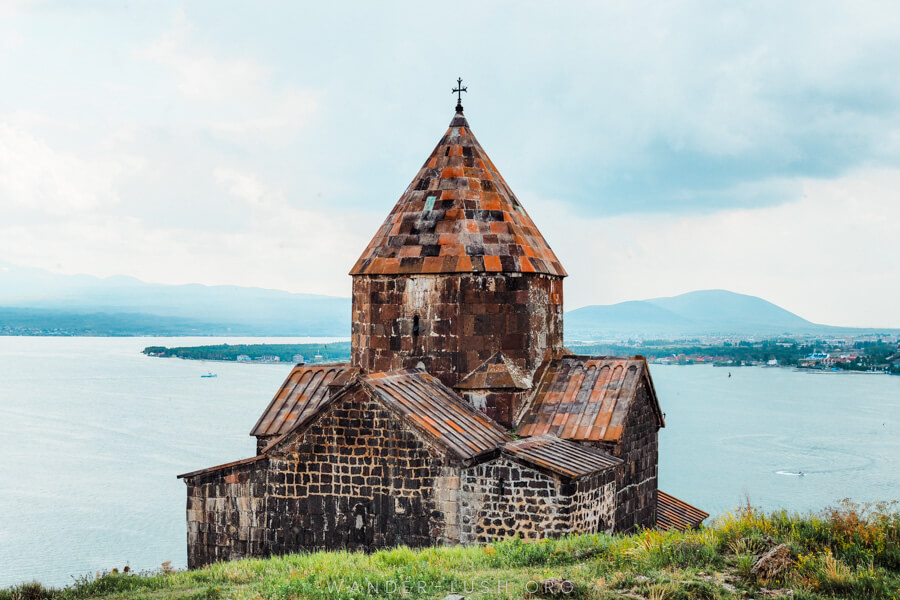
- Armenian name: Sevanavank (‘Sevan Monastery’)
- Year: Founded in 874 AD
- Location:
From its position at the end of the peninsula, Sevanavank stands guard over the largest lake in the Caucasus, Lake Sevan. This area used to be an islet – that was until the fresh-water lake was drained during the Soviet era, reducing the water level and creating a narrow promontory.
Inscriptions indicate that two cruciform churches, Surp Arakelots (‘Holy Apostles’) and Surp Astvatsatsin (‘Holy Mother of God’) were founded here in the year 874 AD by Princess Mariam, daughter of the soon-to-be King Ashot I. It was not a sought-after place, however – the secluded island monastery housed wayward monks from Etchmiadzin who were punished with a wine-free existence and made to copy out manuscripts by hand to repent for their sins.
There isn’t much else to see in this area beyond the monastery. For this reason, I visited Sevanavank as a side trip from the nearby town of Dilijan (the two are only a short bus journey apart). Do be sure to stop by the striking Sevan Writers’ House, located on the southern edge of the peninsula below the monastery.
14. Haghartsin Monastery, a forest church in Dilijan

- Armenian name: Haghartsin (‘Monastery of the Soaring Eagle’)
- Year: Completed in the 13th century
- Location: Dilijan National Park, Tavush Province (2 hours north-east of Yerevan)
Haghartsin or the ‘Monastery of the Soaring Eagle’ is another spectacular example of Armenian church architecture realised in an unbelievably beautiful location. Completely enveloped by thick forest (and stunning in the autumn months), it can either be reached by road or on foot from the nearby town of Dilijan. Hiking to Haghartsin is definitely preferred – the path is part of the Transcaucasian Trail, which winds its way through Georgia, Armenia and Azerbaijan.
The complex has three main churches: St. Astvatsatsin (the largest structure), St. Gregory and St. Stepanos, each with their own gavit. The old refectory is particularly interesting to visit because it’s still used to this day to host guests after marriage and baptism ceremonies.
The final piece of the puzzle, the Bagratuni Sepulchre, is the final resting place for several members of the Bagratid Dynasty who presided over the most prolific era of church-building in Armenian history. Don’t miss the nearby bakery that serves ‘brie bread’, fresh-baked bread stuffed with ooey gooey brie cheese!
15. Cathedral of the Holy Mother of God, a reconstructed church in Gyumri
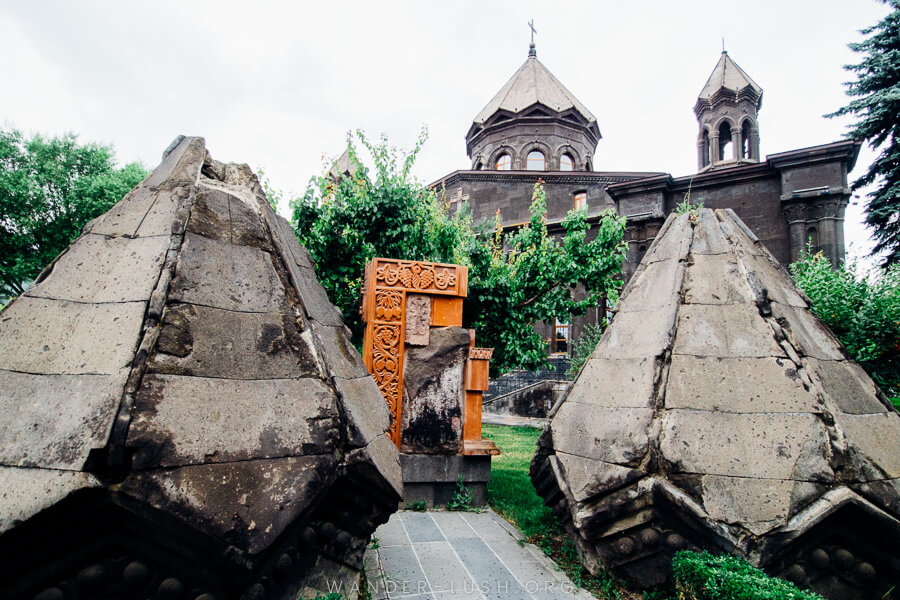
- Armenian name: Surb Astvacacin Mayr Ekegheci
- Year: Completed in 1884
- Location: Gyumri (2 hours north of Yerevan)
One of two monumental churches in the centre of Armenia’s second-largest city, Gyumri, this cathedral – also known as Our Lady of Seven Wounds – sits on the northern side of the main square, Vartanants.
Made from heavy blocks of basalt, the church’s charcoal-coloured facade matches many other buildings in the city. A small garden path ushers visitors to the main entrance. As you approach, you’ll notice several large stone domes positioned amongst the cherry trees. These are the original church cupolas, which came tumbling down during the devastating Spitak Earthquake in December 1988. Instead of being carted away, they were left in their position as a reminder of the destruction – and as a symbol of hope.
Three new domes were added, restoring the church to its former glory. It remains an active place of worship for Gyumri’s residents today.
16. Holy Saviour’s Church, a monumental tuff stone church in Gyumri

- Armenian name: Surb Amenaprkich Ekegheci
- Year: Completed in 1872
- Location: Gyumri (2 hours north of Yerevan)
Gyumri’s biggest church, Holy Saviour’s, sadly hasn’t fared quite as well. Located at the opposite end of Vartanants Square, it was consecrated a few decades after the Cathedral of the Holy Mother of God in 1873 and designed by architect Tadeos Andikyan, the ‘master of masters’ when it came to church architecture. He based his design off the nearby Cathedral of Ani and built the grand structure from black stone, using golden tuff detailing for the arced windows and belltower.
In the 1930s, the cathedral was confiscated by the Soviet government and used as a museum then a concert hall. The 1988 earthquake severely damaged the building, prompting a massive renovation process that started in 2002 and still hasn’t finished.
For the moment it’s impossible to enter the cathedral. It’s definitely worth walking around the periphery, though. At the back, you’ll find a memorial to the earthquake victims.
17. Marmashen, a red tuff monastery near Gyumri
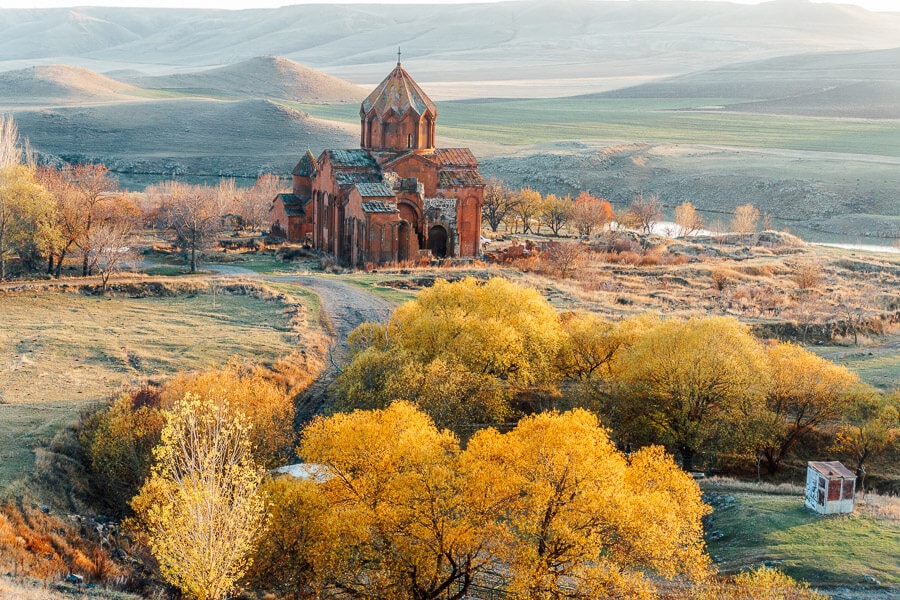
- Armenian name: Marmashenvank
- Year: Completed in 1029 AD
- Location: Marmashen, Shirak Province (2.5 hours north of Yerevan or 20 minutes from Gyumri)
Located just outside Gyumri, Marmashen is a tuff stone monastery kneeling on the bank of the Akhuryan River. Founded at the turn of the 10th century by Prince Vahram Pahlavouni, a military commander under the Bagratids, it features no fewer than five churches, all crafted from pretty red and pink stone.
Built around the same time as Ani’s churches, it is considered part of the same school of architecture. Marmashen is a short taxi ride from Gyumri and easy to visit from the city.
18. Church of the Holy Archangels, a unique church in Vagharshapat
- Armenian name: Srboc Hreshtakapetac Ekegheci
- Year: Completed in 2011
- Location: Vagharshapat (30 minutes west of Yerevan)
The Church of the Holy Archangels lies within the Mother See of the Holy Etchmiadzin complex – and yet it’s a complete visual contrast to Armenia’s oldest church. From the outside, the circular building looks more like a defensive tower (or even a granary!). Step inside, and you can see how the modern design mirrors an ancient gavit, such as the chamber at Geghard.
The same effect is achieved with high walls of polished stone capped off with a ring of small windows around the dome. Light filters down in sharp beams or sweeping frames depending on the time of day. The design of the memorial wall in the church yard, meanwhile, is reminiscent of the Yerevan Cascade. Semi-circular openings act as little windows for a collection of khachkar stones.
Since it was consecrated in 2011, the Church of the Holy Archangels has served as a place for deacons and students of the nearby Gevorkian Theological Seminary to hold their daily devine liturgy services. Visitors are welcome to attend.
19. Saghmosavank & Hovhannavank, lesser-known monasteries near Yerevan
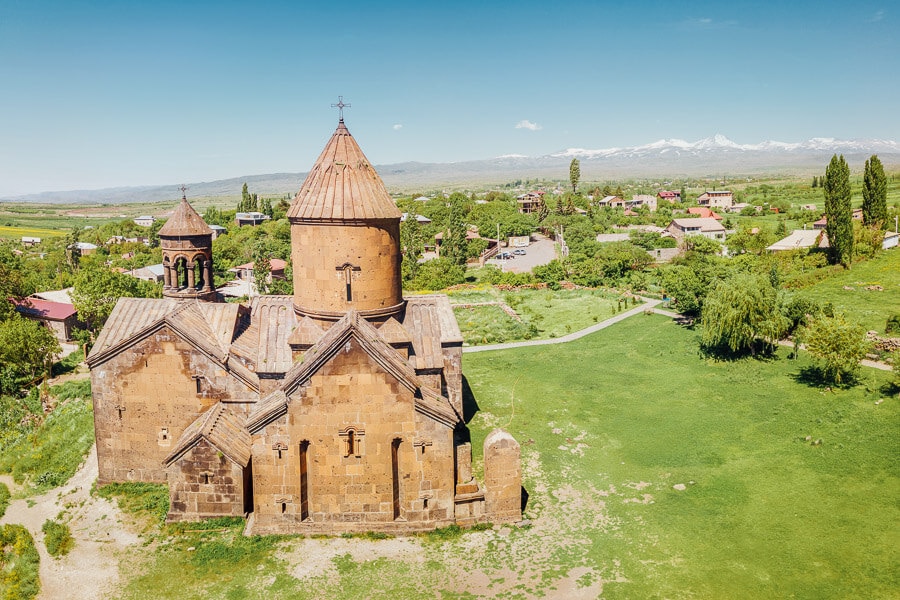
- Armenian names: Saghmosavank (‘Monastery of the Psalms’) & Hovhannavank (‘Jonah’s Monastery’)
- Years: Completed in the 13th century
- Location: Aragatsotn Province (30-60 minutes north of Yerevan)
Though not nearly as well-known as Geghard or Noravank, these two ancient monasteries just outside Yerevan on the Kasakh River are both very popular among locals.
The first, Saghmosavank or ‘Monastery of the Psalms’, was commissioned by Prince Vache Vachutyan and built between 1215-1221. Five kilometres north, Hovhannavank is dedicated to John the Baptist and features a grand cathedral, also completed in 1221.
This area is known for its walking trails and canyon views, making it a great retreat from the city in summer. Hiking between the two monasteries takes around 2 hours – start from Saghmosavank and walk south, the route is mostly downhill.
20. Akhtala, a monastery with immaculate wall frescoes in Lori

- Armenian name: Pghindzavank (‘Coppermine Monastery’)
- Year: Completed in the 10th century
- Location: Akhtala, Lori Province (3.5 hours north-east of Yerevan)
Nestled in the picturesque Debed Canyon north of Haghpat and Sanahin, Akhtala contains an Armenian Orthodox Church famous for its vivid wall frescoes. While most monasteries on this list have an austere interior, Akhtala is a welcome contrast, with large-scale paintings decorating almost every surface – arches, niches and all.
Taken as a whole, Akhtala is a large medieval defensive fortress – thus the first thing you notice on approach is the high stone walls that cradle the chapel. The murals inside Surp Astvatsatsin are considered some of the best examples of Byzantine art outside of the Eastern Roman Empire’s borders. Painted between 1205 and 1216, scenes from the New and Old Testaments are brightly coloured and bear scriptures in Armenian, Georgian and Greek.
Interestingly, all three groups venerate Akhtala Monastery and make a joint pilgrimage here every year on September 20-21. Greeks from the Ottoman Empire first settled here in the 18th century to work in the gold and silver mines and ended up worshipping at Akhtala. The monastery’s alternative name, Pghindzavank, means ‘coppermine monastery’ in Armenian – a nod to the main industry in the Debed Canyon area.
21. Kecharis Monastery, an 11th century monastery in the Valley of Flowers

- Armenian name: Kecharisi Vanqayin Hamalir
- Year: Founded in the 11th century
- Location: Tsaghkadzor, Kotayk Province (an hour north-east of Yerevan)
The 11th-century Kecharis Monastery is situated in the popular resort town of Tsaghkadzor. Come December when the town morphs from a spa retreat into a winter sports resort, the church is clearly visible from the ski slopes!
Kecharis contains five separate churches and a gavit. The biggest and oldest, the church of Saint Grigor, was completed in 1013 and features unique triangular openings behind the altar that allow light bursts to stream in.
Nestled in the high Tsaghkunyats mountains, Tsaghkadzor means ‘valley of flowers’ in Armenian. Spring is also a nice time to visit, when the wildflowers and poppies come into bloom.
Armenian churches FAQ
How many churches are there in Armenia?
There are an estimated 4,000 monasteries and churches in Armenia. Many more lie outside the boundaries of the modern-day Republic of Armenia, in the autonomous region of Nagorno-Karabakh (Artsakh), Turkey and Georgia.
What is the oldest Armenian church?
Echmiadzin Cathedral is considered the oldest church in Armenia. According to some sources, it was completed in 303 AD, making it the oldest Christian cathedral in the world.
How old is the Armenian Orthodox church?
The Armenian Apostolic Church is 1,721 years old. It was founded in the year 301 AD, when the Kingdom of Armenia became the first nation to adopt Christianity as its state religion. That’s two decades before Christianity became the official religion of the Roman Empire.
Which of these Armenian churches is your favourite? Are there any other monasteries or cathedrals you think I should add to the list?
Armenia Travel Guide
Discover insider tips, itinerary inspiration, and all the best things to see, do and experience in Armenia!
Armenia Essentials
My favourite resources and tools for planning a trip to Armenia.
Find affordable flights to Armenia
Yerevan Airport transfer
Save on museums & transport
Hire a car in Armenia
Get an e-visa for Armenia
Find the perfect accommodation
Book city tours & day trips
Order the latest Lonely Planet
More from Armenia
- The Ultimate Armenia Itinerary
- Things to do in Yerevan, 25 must-sees and alternative spots
- Where to find authentic and meaningful Armenian souvenirs in Yerevan
- Don’t miss the GUM Market, Yerevan’s colourful produce hall
- Tips for being a responsible tourist in Armenia
- The best day trip from Yerevan
- Guide to Gyumri, Armenia’s second city
- Guide to visiting the UNESCO monasteries, Haghpat and Sanahin
- How to travel between Armenia and Georgia by overnight train
- 12 things you should know before travelling to the Caucasus
Armenia Travel Guide
Discover insider tips, itinerary inspiration, and all the best things to see, do and experience in Armenia!
Armenia Essentials
My favourite resources and tools for planning a trip to Armenia.
Find affordable flights to Armenia
Yerevan Airport transfer
Save on museums & transport
Hire a car in Armenia
Get an e-visa for Armenia
Find the perfect accommodation
Book city tours & day trips
Order the latest Lonely Planet
More from Armenia
- The Ultimate Armenia Itinerary
- Things to do in Yerevan, 25 must-sees and alternative spots
- Where to find authentic and meaningful Armenian souvenirs in Yerevan
- Don’t miss the GUM Market, Yerevan’s colourful produce hall
- Tips for being a responsible tourist in Armenia
- The best day trip from Yerevan
- Guide to Gyumri, Armenia’s second city
- Guide to visiting the UNESCO monasteries, Haghpat and Sanahin
- How to travel between Armenia and Georgia by overnight train
- 12 things you should know before travelling to the Caucasus
